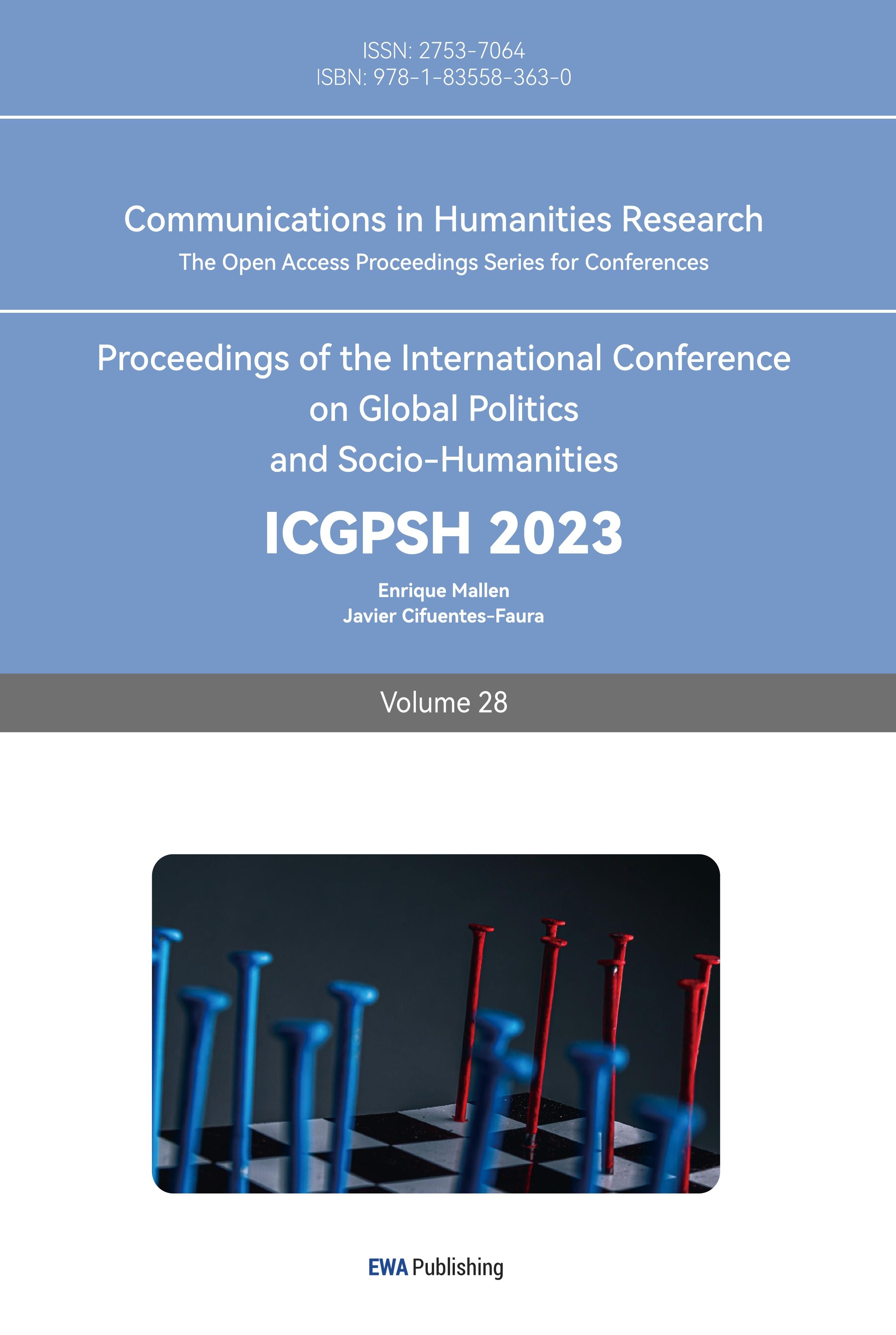1.Introduction
The Silk Road, an ancient trade route connecting East and West, is a testament to historical and cultural interactions that changed the world. There were exchanges of religions, commodities, ideas, and architectural influence. One aspect of this exchange is the Islamic architecture with Chinese traditional architectural styles, which presents a unique style. The culture came to China in the Tang dynasty. By examining the past and present Chinese Islamic architecture, we can better understand culture exchange, architectural technique, and syncretism in architectural style. This research paper focuses on the current situation and prospects of studying the Silk Road and Chinese Islamic architecture. Many sites exist in China, such as TongXin mosque, Xianxian Mosque in Guangzhou, and Quanzhou. This research seeks to contribute to the cultural study, promoting a deeper appreciation for the heritage and global connection embodied by the Silk Road and Chinese Islamic architecture. By recognizing the enduring significance, we can gain valuable insights into the past while enhancing our understanding of the present.
2.Silk Road: Islam and China
The Silk Road was an extensive network of trade routes that facilitated the initial transmission of Islamic ideas and values from the Middle East to various regions along this distinct pathway. Thus catalyzing cultural exchange. Muslim merchants, who actively engaged in commercial activities along these routes, did not only trade commodities but also disseminated the religious belief of Islam to the local populations they encountered along the path. This part explores the impact of the Silk Road on the propagation of Islam in China, highlighting the role of Muslim merchants as agents of cultural diffusion.
The arrival of Islamic merchants along the Silk Road led to the establishing of settlements and trading posts, which set the critical centers for cultural exchange for later days. Through their interactions with diverse communities, these merchants introduced Islamic customs, practices, and teachings, fostering an environment of intellectual curiosity and religious dialogue. The historical records indicated that as early as August 25, 652 ADS, envoys from the Arab Caliphate arrived in Chang'an, where they met with Emperor Gaozong of the Tang density and initiated a series of diplomatic exchanges from there. Wang (Wang Yongping) and Wang (Wang Siwen) both pointed out that the subsequent influx of envoys and the flourishing trade between the Arab Caliphate and China had played a significant role in the dissemination of Islamic faith [1].
One noteworthy figure who exemplifies the influence of Islam's spread via the Silk Road is Sa'd ibn Abi Waqqas, a distinguished companion of Prophet Muhammad. Sa'd ibn Abi Waqqas was pivotal in introducing Islam to China during the Tang Dynasty. As an emissary and military commander, he embarked on a remarkable journey, overcoming numerous challenges and traversing vast landscapes to establish a lasting connection between Islamic teachings and the expansive lands of China. His efforts resulted in the construction of the Saad bin Abi Waggas Mosque, which served as the first mosque ever created in China [2, 3]. This historical landmark highlighted the significance of Sa'd ibn Abi Waqqas and underscored the Silk Road's crucial role as a conduit for disseminating Islam in China and the interconnected countries.
Through the collective efforts of individuals like Sa'd ibn Abi Waqqas and the active engagement of Muslim merchants along the Silk Road, a lasting bond was forged between the Islamic world and China, leaving an enduring legacy in history, moreover the architecture style. The enduring presence of Islamic architectural structures in China is tangible evidence of the far-reaching impact of the Silk Road and the spread of Islam. These structures embody the culmination of historical connections and exchanges facilitated by the Silk Road, emphasizing its role in shaping the religious and cultural landscape.
3.Architectural Elements and Styles
Islamic influence on Chinese architecture along the Silk Road is evident in incorporating various architectural elements and styles that reflect the fusion of Islamic and Chinese traditions. These elements served functional purposes and expressed the cultural exchange and religious syncretism occurring along the Silk Road.
3.1.Dome and Arch Structures
One prominent architectural feature adopted from Islamic design is the dome, which became integral to many mosques and religious buildings in China. Domes were not commonly used in traditional Chinese architecture, but the influence of Islamic architecture introduced this distinct feature. The crown symbolizes the celestial realm and the connection between earth and heaven. Its incorporation into Chinese Islamic architecture fulfilled functional needs and conveyed religious symbolism and a sense of spiritual transcendence. This can be demonstrated in the "Mosque of The Ancient" from Guangzhou, a mosque built because of the spread of Islamic culture by the Arab man Saad·Bin·Abbi·Wangal in the 7th century. We can see the dome on the top of the building, but we can also see that the building has original Chinese features, such as the pillar.
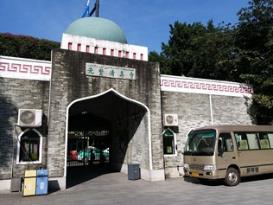
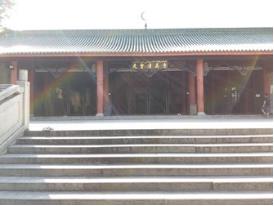
Figure 1: The Dome of the Mosque Figure 2: The Entrance of the Mosque
Additionally, the extensive use of arches in Chinese Islamic architecture showcases the influence of Islamic design principles. Arches provided structural stability and allowed spacious interiors without excessive columns or supports. Adopting pointed arches, commonly found in Islamic architecture, influenced the development of distinctive Chinese arch styles such as the horseshoe and ogee arch. These arch forms added aesthetic appeal and further exemplified the fusion of Islamic and Chinese architectural traditions [4].
3.2.Geometric Patterns and Calligraphy
Islamic architecture influence is also manifested in the intricate geometric patterns and calligraphic inscriptions that adorn the surfaces of Chinese Islamic buildings. Islamic art places great emphasis on geometric designs as a reflection of the infinite nature of God's creation. Chinese Islamic architecture assimilated these geometric patterns into decorative elements such as tiles, woodcarvings, and plasterwork. The precise craftsmanship and geometric intricacy seen in these designs demonstrate the influence of Islamic aesthetics on Chinese architectural ornamentation.
In addition to geometric patterns, calligraphy is significant in Islamic culture and is often incorporated into architectural elements. Chinese Islamic architecture often features calligraphic inscriptions of Quranic verses, religious phrases, or names of important figures. These inscriptions, carved or painted onto building facades or interior surfaces, serve as decorative elements and express the religious devotion and reverence associated with Islamic tradition.
Integrating these architectural elements and styles demonstrates the cross-cultural exchange and adaptation along the Silk Road. The fusion of Islamic and Chinese architectural traditions resulted in a unique and distinct architectural expression that reflected the shared cultural heritage and religious syncretism between these two civilizations [5].
4.Visual Analysis of the Current Status of Research on the Silk Road and Islamic Architecture
This study employs the Web of Science core collection as the primary database. It utilizes the bibliometric software VOSviewer to comprehensively analyze the research landscape about the Silk Road and Islamic architecture. This analysis explores the current state of architectural research on the Silk Road, Islamic architectural research, and the interaction between the Silk Road and the spread of Islamic architectural styles. To summarize the current lack of research and to provide a direction for future research on the Silk Road and architecture.
The study is divided into two distinct categories. The first category focuses on identifying the heated topics related to Silk Road studies and exploring the focus of architecture associated with Silk Road Studies. Through the combination of "Silk Road" with keywords such as "archaeology", "cultural exchange", "religion", "history," and "architecture", we aim to compare the Silk Road and architectural studies generally differ in number from Silk Road and the other four types of analyses. Then, this paper focuses on discerning prevailing academic interests of research relating to both "The Silk Road" and "architecture" by looking at focal points such as "cultural heritage", "design", "style", "communication", and "China". We strive to gain deeper insights into the focal points of Silk Road architecture research [6]. Additionally, we employ the conjunction of "Silk Road" and "Islamic architecture" to offer a more precise, intuitive, and meticulous evaluation of the current advancements in research on Islamic architecture along the Silk Road.
The second category of this study concentrates on Islamic architecture research by investigating two distinct types of keywords. Firstly, "Islamic architecture" serves as a standalone keyword to comprehensively assess the overall scope of research in this domain and form a holistic understanding. This enables us to discern the prevailing academic research interests and attention dedicated to the Islamic architecture of the Silk Road. Secondly, we combine "Islamic architecture" with terms such as "mosque", "style", "communication", "area studies", and "country" to examine the nuanced aspects of architectural style and its communication within the field of Islamic architecture studies. As mentioned in part II of this paper, we identified that Islamic architectural style is essential in academic research. Thus, we want to determine whether extensive attention is paid to this topic.
Through the above categorization, we hope to analyze the focus of Silk Road studies on architecture through the architectural studies on the Silk Road and the current direction of Islamic architectural studies through the proportion of architectural style dissemination in Islamic architectural studies. From there, it combines the two to draw inferences about the relationship between the Silk Road and the spread of Islamic architectural styles.
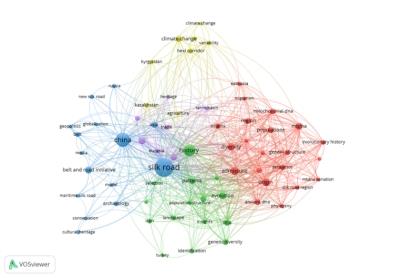
Figure 3: The Silk Road and History Research
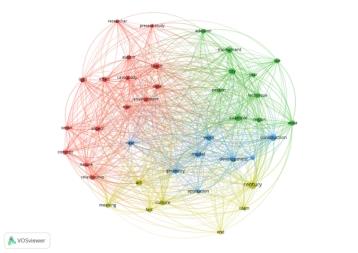
Figure 4: Islamic architecture research
A comprehensive analysis was conducted on 392 documents about Silk Road and history studies spanning the period from 1985 to 2023, but there is insufficient research on Islamic architecture. As Figure 3 shows, the findings of the visual analysis reveal that historical research on the Silk Road primarily focuses on archaeological and regional historical investigations, with a limited emphasis on architecture. Moreover, the architectural research on the Silk Road predominantly centers around multidisciplinary fields such as engineering, genetics heredity, applied physics, or construction of buildings rather than architecture architectural style. However, 24 articles were identified when searching for the combination of "Silk Road" and "architecture." Concerning Islamic architecture, the research concentration is notably modest, with only one article specifically dedicated to "Islamic architecture". Farr, Marcus M.'s Silk Road: a reference. Creating Public Architectural Intervention in the Context of Education & Technology article, but it is worth noting that this article is written from a technological design. Still, it is worth noting that this article is written from a technology design perspective, utilizing the forms of several Islamic buildings along the Silk Road to create new architecture [7].
Similarly, 304 documents were examined for Islamic architecture studies within the same timeframe, but research related to architecture-style communication is insufficient. As Figure 4 shows, Islamic architecture research primarily centers around four main aspects. Firstly, there is a focus on studying architectural regions, encompassing geographic areas and specific localities. For instance, the article Recognizing Karbandi in Iran's Architecture and a Review of Its Decorative-Structural Role. by Saremi Naeeni, Davoud, et al. Recognizing and reviewing the decorative and structural functions of Karbandi in Iran's characteristic religious architecture [8]. Secondly, the analysis delves into architectural culture's artistic, cultural, and symbolic dimensions. For example, The Abbasid Mosaic Tradition and the Great Mosque of Damascus by Leal, B (Leal, Bea) details the surviving mosaics on the Great Mosque of Damascus [9]. Thirdly, architectural works, domes, geometry, and construction are examined from the perspective of architecture itself. The article Development and Evolution of Palmette Ornament: An Influence on Islamic Architecture explored how palmette ornaments are practiced in Islamic architecture [10]. Lastly, investigations encompass certain regions' current state and distinctive architectural features, including studies on contemporary trends and spatial considerations, such as Rabbat, N's article Continuity, and Rupture in Islamic Architecture [11]. On the other hand, the research attention dedicated to architectural style communication is insufficient, as evidenced by a mere 16 articles identified through the combination of "Islamic architecture" and "style". Research in this domain leans more towards multidisciplinary fields such as engineering, archaeology, art, or history. For example, A Short Review of Influencing Factors of Islamic Architecture in Aleppo, Syria, reveals the history of Aleppo's urban development and its influence by Islamic civilization from the late Ottoman Empire to the Syrian Civil War in 2011. The study shows how Islamic culture influenced Aleppo's residential buildings regarding simplicity, respect for human scale, equality, and privacy [12]. Another example is the article Fractal Dimension of Islamic Architecture: The Case of the Mameluke Madrasas: Al-Sultan Hassan Madrasa, which uses the example of the madrasa to argue that Islamic architecture is a successful example in extracting the mathematical proportions and fractal geometry of natural organisms [13].
To summarize, both Silk Road and Islamic architecture studies have not adequately explored the transmission and dissemination of Islamic architectural styles along the Silk Road. Nevertheless, it is worth noting that Islamic architecture did influence the architectural styles of cities along the Silk Road, such as Xi'an and Guangzhou in China. As mentioned in the second part, the “Mosque of The Ancient”, dome and arch structures, geometric shapes and calligraphy, etc. Consequently, it can be inferred that the Silk Road played a significant role in the diffusion and adoption of Islamic architectural styles and designs.
Notably, as of May 2020, 61 national critical cultural relics protection units designated by the State Council of China are affiliated with Islamic architecture, highlighting the importance of examining the interaction between Islamic architectural styles and the Silk Road. However, concerning the current situation, there are more studies on the spread of the Silk Road and Islam and the spread of Islam and Islamic architectural styles. At the same time, there is a lack of connecting the Silk Road and the space of Islamic architectural styles. Therefore, it should start from the Islamic architecture of the countries along the Silk Road in a certain period and establish a connection between the Silk Road and the spread of Islamic architectural style by exploring the similarities and differences in the types of architecture of different countries as well as their participation in the trade and cultural exchanges along the Silk Road.
5.Conclusion
In conclusion, the Islamic architecture in China represents the exchange of culture that the Silk Road played in the propagation of Islam in China, facilitating cultural exchange and the dissemination of Islamic ideas and values. Muslim merchants along the Silk Road engaged in trade and spread their religious beliefs to the local populations they encountered. The architectural elements and styles in Chinese Islamic buildings along the Silk Road reflect the fusion of Islamic and Chinese traditions. However, the amount of current research on disseminating Islamic architectural style on the Silk Road in our understanding requires further investigation. The visual analysis reveals limited attention given to architecture within Silk Road studies and a modest concentration on architectural style communication in Islamic architecture research. The study of the impact of the Silk Road on Islam in China and the architectural influences helps us appreciate the historical connections, cultural exchange, and shared heritage between Islamic and Chinese civilizations. Further research in these areas will enhance our understanding of this significant historical phenomenon and promote intercultural understanding.
6.Limitation
This research paper on the Silk Road and Chinese Islamic architecture is subject to certain limitations, which should be acknowledged to provide a comprehensive understanding of the scope and potential implications of the study. The following rules are identified:
Time Constraints: The research was conducted within a specific time frame, limiting the study's depth and breadth. The available time might not have allowed for an exhaustive examination of all relevant literature and sources. Consequently, some valuable information and perspectives might have been overlooked, potentially impacting the completeness of the findings.
Lack of First-hand Resources: Due to practical limitations, such as geographical constraints and resource accessibility, the study relied heavily on existing literature, secondary sources, and digital databases. This reliance on secondary sources may have introduced biases or limited the availability of specific details or firsthand accounts. Not being able to personally visit particular locations, such as the mosques along the Silk Road or the Middle East, hindered primary data collection and restricted the ability to observe and analyze architectural elements and styles directly.
Scope and Generalization: The study primarily focused on mosques in Chinese regions along the Silk Road and aimed to analyze their architectural features. While efforts were made to include a representative sample, it is essential to acknowledge that the selected mosques may not fully represent the diversity and complexity of Islamic architecture along the entire Silk Road. Consequently, the findings and conclusions of this study may not be universally applicable and should be interpreted within the defined scope of the research.
Cultural and Historical Context: The research paper aimed to provide insights into the influence of Islamic architectural styles on China along the Silk Road. However, the study was limited in profoundly exploring the intricate cultural, historical, and religious contexts surrounding the architecture. Understanding these contextual factors is crucial for a comprehensive analysis but was beyond the scope of this research.
Despite these limitations, this study contributes to the existing literature by examining the current situation and research prospects on the Silk Road and Chinese Islamic architecture. The findings and recommendations presented in this paper provide a foundation for further research in this field and promote a deeper understanding of the cultural exchange and architectural syncretism between Islamic and Chinese traditions along the Silk Road.
References
[1]. Wang Yongping and Wang Siwen. (2022) The Enlightenment of Global Historical Views on the Study of the Silk Road. Journal of Historical Records, no. 3.
[2]. Ma Tong. (2000) Muslim Culture on the Silk Road. Ningxia people’s publishing house, Yinchuan.
[3]. Jeong, J. (2022) Little Mecca in Canton: representations and resurgences of the graveyard of Sa’d ibn Abī Waqqās. Taylor & Francis.
[4]. Hillenbrand, R. (2016) Studying Islamic architecture: Challenges and perspectives: Architectural history. Cambridge Core. https://www.cambridge.org/core/journals/architectural-history/article/abs/studying-islamic-architecture-challenges-and-perspectives/62A02D79AABD3C7573F8E9977D8AE119
[5]. Grabar, O. (2005) Constructing the study of Islamic Art. 650-II00. Routledge, London.
[6]. Song Hui and Li Sichao. (2021) The Development History and Prospects of Islamic Architecture Research in China. Journal of Architecture, no. S1, pp. 33–39.
[7]. Farr, M.M. (2017) Silk Road: A Reference. Creating Public Architectural Intervention in the Context of Education & Technology. Design Journal, vol. 20, pp. S4019–37. Clarivate Analytics Web of Science, https://doi.org/10.1080/14606925.2017.1352904.
[8]. Saremi, N., Davoud. et al. (2018) Recognising Karbandi in Iran’s Architecture and a Review of Its Decorative-Structural Role. Iran, vol. 56, no. 2, pp. 173–83. DOI.org (Crossref), https://doi.org/10.1080/05786967.2017.1406789.
[9]. Leal., Bea. (2020) The Abbasid Mosaic Tradition and the Great Mosque of Damascus. Muqarnas: An Annual on the Visual Cultures of the Islamic World, vol. 37, Brill, pp. 29–62. Clarivate Analytics Web of Science, https://doi.org/10.1163/22118993-00371P03.
[10]. Zahra., Fatima., Safrizal, S. (2022) Development and Evolution of Palmette Ornament: An Influence on Islamic Architecture. Landscape Architecture and Art, vol. 21, no. 21, pp.124–30. Clarivate Analytics Web of Science, https://doi.org/10.22616/j.landarchart.2022.21.13.
[11]. Rabbat, N. (2021) Continuity and Rupture in Islamic Architecture. International Journal of Islamic Architecture, vol. 10, no. 1, pp. 47–55. Clarivate Analytics Web of Science, https://doi.org/10.1386/ijia_00028_1.
[12]. Noaime, E., et al. (2020) A Short Review of Influencing Factors of Islamic Architecture in Aleppo, Syria. Engineering Technology & Applied Science Research, vol. 10, no. 3, pp. 5689–93.
[13]. Abdelsalam, M., Mohamed, I. (2019) Fractal Dimension of Islamic Architecture: The Case of the Mameluke Madrasas: Al-Sultan Hassan Madrasa. Gazi University Journal of Science, vol. 32, no. 1, pp. 27–37.
Cite this article
Sun,H.;Wahdan,M.;Wen,H. (2024). The Current Situation and Prospect of the Research on the Silk Road and Chinese Islamic Architecture. Communications in Humanities Research,28,151-158.
Data availability
The datasets used and/or analyzed during the current study will be available from the authors upon reasonable request.
Disclaimer/Publisher's Note
The statements, opinions and data contained in all publications are solely those of the individual author(s) and contributor(s) and not of EWA Publishing and/or the editor(s). EWA Publishing and/or the editor(s) disclaim responsibility for any injury to people or property resulting from any ideas, methods, instructions or products referred to in the content.
About volume
Volume title: Proceedings of the International Conference on Global Politics and Socio-Humanities
© 2024 by the author(s). Licensee EWA Publishing, Oxford, UK. This article is an open access article distributed under the terms and
conditions of the Creative Commons Attribution (CC BY) license. Authors who
publish this series agree to the following terms:
1. Authors retain copyright and grant the series right of first publication with the work simultaneously licensed under a Creative Commons
Attribution License that allows others to share the work with an acknowledgment of the work's authorship and initial publication in this
series.
2. Authors are able to enter into separate, additional contractual arrangements for the non-exclusive distribution of the series's published
version of the work (e.g., post it to an institutional repository or publish it in a book), with an acknowledgment of its initial
publication in this series.
3. Authors are permitted and encouraged to post their work online (e.g., in institutional repositories or on their website) prior to and
during the submission process, as it can lead to productive exchanges, as well as earlier and greater citation of published work (See
Open access policy for details).
References
[1]. Wang Yongping and Wang Siwen. (2022) The Enlightenment of Global Historical Views on the Study of the Silk Road. Journal of Historical Records, no. 3.
[2]. Ma Tong. (2000) Muslim Culture on the Silk Road. Ningxia people’s publishing house, Yinchuan.
[3]. Jeong, J. (2022) Little Mecca in Canton: representations and resurgences of the graveyard of Sa’d ibn Abī Waqqās. Taylor & Francis.
[4]. Hillenbrand, R. (2016) Studying Islamic architecture: Challenges and perspectives: Architectural history. Cambridge Core. https://www.cambridge.org/core/journals/architectural-history/article/abs/studying-islamic-architecture-challenges-and-perspectives/62A02D79AABD3C7573F8E9977D8AE119
[5]. Grabar, O. (2005) Constructing the study of Islamic Art. 650-II00. Routledge, London.
[6]. Song Hui and Li Sichao. (2021) The Development History and Prospects of Islamic Architecture Research in China. Journal of Architecture, no. S1, pp. 33–39.
[7]. Farr, M.M. (2017) Silk Road: A Reference. Creating Public Architectural Intervention in the Context of Education & Technology. Design Journal, vol. 20, pp. S4019–37. Clarivate Analytics Web of Science, https://doi.org/10.1080/14606925.2017.1352904.
[8]. Saremi, N., Davoud. et al. (2018) Recognising Karbandi in Iran’s Architecture and a Review of Its Decorative-Structural Role. Iran, vol. 56, no. 2, pp. 173–83. DOI.org (Crossref), https://doi.org/10.1080/05786967.2017.1406789.
[9]. Leal., Bea. (2020) The Abbasid Mosaic Tradition and the Great Mosque of Damascus. Muqarnas: An Annual on the Visual Cultures of the Islamic World, vol. 37, Brill, pp. 29–62. Clarivate Analytics Web of Science, https://doi.org/10.1163/22118993-00371P03.
[10]. Zahra., Fatima., Safrizal, S. (2022) Development and Evolution of Palmette Ornament: An Influence on Islamic Architecture. Landscape Architecture and Art, vol. 21, no. 21, pp.124–30. Clarivate Analytics Web of Science, https://doi.org/10.22616/j.landarchart.2022.21.13.
[11]. Rabbat, N. (2021) Continuity and Rupture in Islamic Architecture. International Journal of Islamic Architecture, vol. 10, no. 1, pp. 47–55. Clarivate Analytics Web of Science, https://doi.org/10.1386/ijia_00028_1.
[12]. Noaime, E., et al. (2020) A Short Review of Influencing Factors of Islamic Architecture in Aleppo, Syria. Engineering Technology & Applied Science Research, vol. 10, no. 3, pp. 5689–93.
[13]. Abdelsalam, M., Mohamed, I. (2019) Fractal Dimension of Islamic Architecture: The Case of the Mameluke Madrasas: Al-Sultan Hassan Madrasa. Gazi University Journal of Science, vol. 32, no. 1, pp. 27–37.





